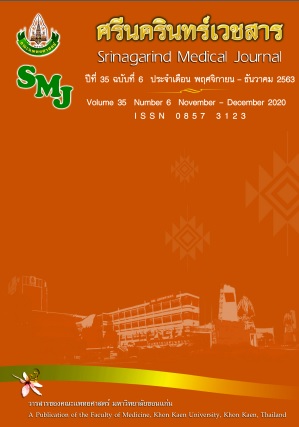Optimization of Colorimetric Assay of Loop Mediated Isothermal Amplification for Detections of Mycobacterium tuberculosis
Abstract
การปรับปรุงวิธีการตรวจแบบทำให้เกิดสีของวิธี Loop Mediated Isothermal Amplification เพื่อตรวจหาเชื้อมัยโคแบคทีเรียม ทิวเบอร์คิวโลสิส
จิตตนันท์ ศรีสุทัศน์1, อรุณนี สังกา2, วิเศษ นามวาท3
1นักศึกษาปริญญาโทสาขาวิชาจุลชีววิทยาทางการแพทย์ ภาควิชาจุลชีววิทยา คณะแพทยศาสตร์มหาวิทยาลัยขอนแก่น
2ภาควิชาจุลชีววิทยาคลินิก คณะเทคนิคการแพทย์ มหาวิทยาลัยขอนแก่น
3ภาควิชาจุลชีววิทยา คณะแพทยศาสตร์มหาวิทยาลัยขอนแก่น
Background and objectives: Tuberculosis is an airborne disease caused by Mycobacterium tuberculosis (MTB). It is a major public health problem of Thailand and worldwide, ranking as the second leading cause of death from worldwide infectious diseases. Diagnosis development is one of key factors to control it. The objective of this study was to optimize the colorimetric method of Loop-mediated isothermal amplification (LAMP), which is a new promising method because DNA is synthesized at a single temperature in relatively short period.
Methodology: The LAMP was set-up to detect the genomic DNA of MTB. The amplified product was detected by using Hydroxy naphthol blue (HNB), Sybergreen (SYBR) and gel electrophoresis. The amount of HNB was optimized for detection compare to the results of using SYBR and gel electrophoreses.
Results: Pre-addition of 5 mM HNB to the LAMP reaction solution showed observe-able blue-sky color of positive but did not interfere amplification efficiency. The minimum detection limit between using HNB, SYBR and gel electrophoresis were 10, 100 and 10 pg of MTB genomic DNA, respectively.
Conclusion: The colorimetric LAMP method using HNB was successfully optimized for detection of MTB. The optimal of concentration of HNB was 5mM and the minimum detection limit was 10 pg of MTB genomic DNA which is similar to those of gel electrophoresis.
หลักการและวัตถุประสงค์: วัณโรคมีสาเหตุจากเชื้อมัยโคแบคทีเรียม ทิวเบอร์คิวโลสิส (Mycobacterium tuberculosis) เป็นปัญหาหลักทางสาธารณสุขของไทยและทั่วโลก นอกจากนี้ยังเป็นสาเหตุการตายอันดับที่สองของการเสียชีวิตจากโรคติดเชื้อทั่วโลก การพัฒนาการตรวจวินิจฉัยวัณโรคเป็นปัจจัยสำคัญอย่างหนึ่งในการควบคุมวัณโรค การศึกษานี้มีวัตถุประสงค์เพื่อปรับการตรวจวัดด้วยสีให้เหมาะสมที่สุดในขั้นตอนการตรวจวัดหลังการเพิ่มปริมาณ DNA ด้วยเทคนิค Loop-mediated isothermal amplification (LAMP) ซึ่งเป็นวิธีที่สะดวกและรวดเร็วในการตรวจวินิจฉัย
วิธีการศึกษา: ได้ใช้เทคนิค LAMP เพื่อใช้ในการตรวจหาดีเอ็นเอของเชื้อ มัยโคแบคทีเรียม ทิวเบอร์คิวโลสิส ในขั้นตอนการตรวจหาผลผลิตของการเพิ่มจำนวนดีเอ็นเอ มีการใช้ Hydroxy naphthol blue (HNB), Sybergreen (SYBR) และ gel electrophoresis มีการปรับปริมาณและวิธีการใช้ HNB เปรียบเทียบผลจากการใช้ SYBR และ gel electrophoresis
ผลการศึกษา: การใช้ HNB ในการเติมล่วงหน้าก่อนปฏิกิริยาเพิ่มจำนวนดีเอ็นเอ ความเข้มข้นที่เหมาะสมคือ 5 mM โดยผลบวกจะมีการเปลี่ยนสีจากสีม่วงเป็นสีฟ้าและไม่รบกวนปฏิกิริยา การตรวจหาปริมาณ DNA ของเชื้อ MTB ในระดับต่ำสุด ระหว่างการใช้ HNB, SYBR และ gel electrophoresis คือ 10, 100 และ 10 pg ตามลำดับ
สรุป: การตรวจแบบทำให้เกิดสีของวิธี LAMP โดยใช้ HNB ได้รับการปรับให้เหมาะสมสำหรับการตรวจหาเชื้อMTB ความเข้มข้นที่เหมาะสมของ HNB คือ 5mM และตรวจหาปริมาณ DNAของเชื้อ MTB ในระดับต่ำสุดที่ 10 pg ซึ่งคล้ายกับ gel electrophoresis
Keywords: LAMP; Tuberculosis; HNB; Loop-Mediated; Isothermal; Amplification; Hydroxy naphthol blue
คำสำคัญ: วัณโรค


